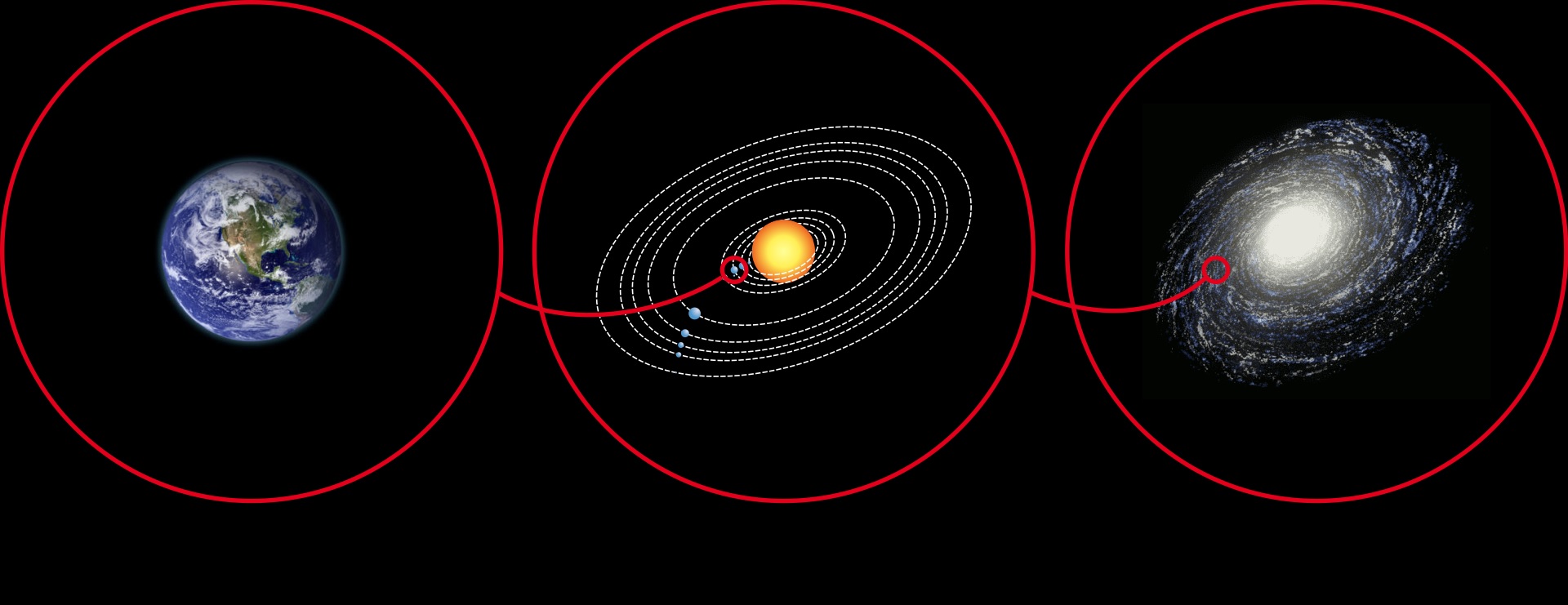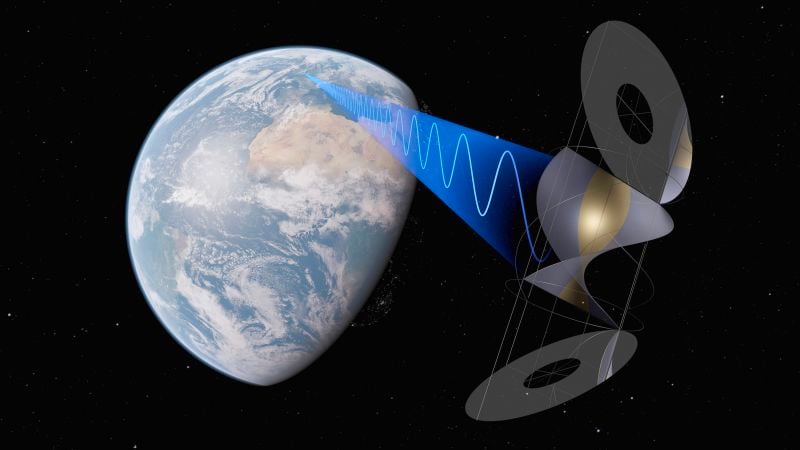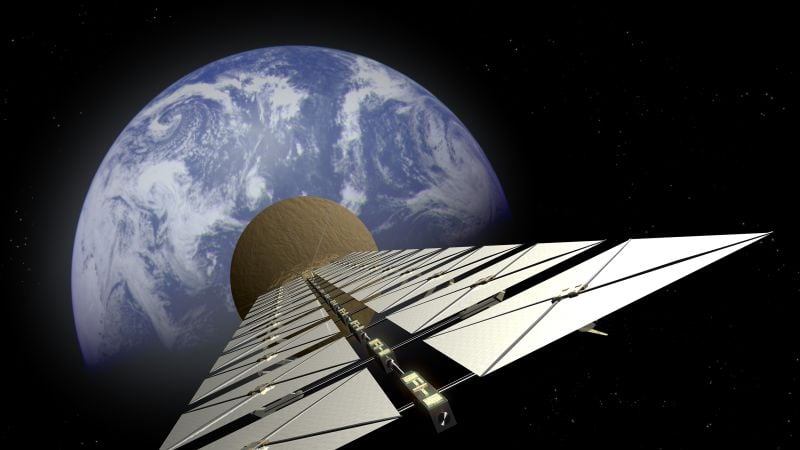Measuring Civilizations in the Universe
In cosmology , the Kardashev scale is a method of measuring the level of development of a civilization. Although theoretical, the Kardashev scale describes a direction of civilization linked to the use of energy.
Accordingly, the basic cosmic civilization is divided into 3 levels. Level I civilization is capable of exploiting and using energy resources in a planet. Level II civilization is capable of exploiting and using energy resources in a star (like our Sun) or other objects in the solar system.

Simulation of the stature of 3 types of civilizations determined by the Kardashev scale. Photo: Wiki
A Level III civilization is much more advanced, where a civilization is capable of harnessing and using the energy of an entire galaxy, like in science fiction movies about intergalactic wars or intergalactic wars.
Thus, if we compare the three levels mentioned above, human civilization is at level I, when it has only exploited the available energy in or on the Earth's surface. However, new advances in space and space science show that we are starting to move towards level II space civilization, when we have plans to exploit energy or other resources from objects in outer space.
And this year, electrical engineering professor Ali Hajimir's team at the California Institute of Technology (Caltech, in California, USA) took a step closer to a plan to produce solar power in space and transmit it back to Earth, a small step that, if successful, would show that humanity could enter a level II space civilization.

Simulation of the British-designed CASSIOPeiA solar power satellite. Solar energy collected from space will be directed to a selected location on the Earth's surface. Photo: Space Solar
How to get energy from space?
Electrical engineering professor Hajimir has spent a decade researching ways to launch solar cells into space and beam the energy back to Earth. In January, his team launched Maple, a 30-centimeter-long space solar prototype equipped with an ultralight, flexible transmitter. The transmitter is designed to collect energy from the Sun and transmit it wirelessly into space. The resulting electricity is enough to power a pair of LED lights.
But the researchers have a long-term goal: to see if Maple can beam this energy down to Earth. In May, the team decided to conduct an experiment to see what would happen. On the roof of the Caltech campus in Pasadena, California, Hajimiri and other scientists picked up Maple’s signal. Although the amount of energy detected was too small to be useful, they still succeeded in transmitting energy wirelessly from space.
In fact, the idea of generating solar power in space has been around since 1941, when science fiction writer Isaac Asimov described it in a short story. In the decades since, countries including the US, China and Japan have explored the idea, but have largely given up over the years.
At its core, solar power generation in space means that humans on Earth can harness the Sun's enormous energy in space, where light is constantly available, unaffected by adverse weather conditions such as cloud cover, time of night or seasons.
There are a variety of ideas for how this could be done, but the general idea is this: Solar-powered satellites measuring more than a mile in diameter would be launched into high-altitude orbits. Because of their massive size, the satellites would be made up of hundreds of thousands of smaller modules. Autonomous robots would then assemble the satellites in space like “building Lego bricks,” explains Martin Soltau, CEO of UK-based Space Solar.
The satellite’s solar panels will collect solar energy, convert it into microwaves, and transmit them wirelessly to Earth via a very large transmitter that can precisely reach specific points on the ground. The microwaves can easily penetrate clouds and bad weather, and reach a receiving antenna made of mesh on Earth, where they will be converted into electricity and fed into the grid, Soltau said.

Microwaves can easily pass through clouds and bad weather, reaching a receiving antenna on Earth. The microwaves are then converted back into electricity and fed into the grid. Image: ESA
Measuring about 6 kilometers in diameter, the receiving antennas can be built on land or offshore. Because these grid structures are nearly transparent, the land beneath them can be used for solar panels, farms, or other activities.
Huge potential and huge challenges
According to scientists' estimates, a solar energy-collecting satellite in space could provide up to 2 gigawatts of electricity, nearly equal to the capacity of two average nuclear power plants in the US.
However, this technology faces a major hurdle: the cost of installing a power plant in orbit is very expensive. Underwood, the British professor, told CNN that space power technology is "not science fiction", however, the biggest obstacle is the huge cost of putting a power plant into orbit.
That has begun to change over the past decade, however, as aerospace companies like SpaceX and Blue Origin have begun developing reusable rockets. Launch costs today are around $1,500 per kilogram, about 30 times lower than during the space shuttle era of the early 1980s.
If successful, the idea of generating solar power in space could provide a vast source of energy for developed countries with large electricity needs but lacking infrastructure. It could also serve remote Arctic towns and villages that are in total darkness for months each year, as well as communities that have lost power due to natural disasters or conflicts.
Although there is still a large gap between concept and commercialization, many countries and companies around the world believe that space solar power can meet the growing demand for clean electricity, while also helping to deal with the current worsening climate crisis.

Simulation of a solar power satellite in space. Photo: ESA
In May 2020, the US Naval Research Laboratory also launched a module on an orbital test vehicle to test solar power generation hardware in space conditions. In addition, the US Air Force Research Laboratory also plans to launch a small test vehicle called Arachne in 2025. The China Academy of Space Technology also aims to launch a solar battery satellite into low orbit in 2028 and high orbit in 2030.
In addition, the European Union is developing the Solaris program to determine the technical feasibility of solar power in space. Meanwhile, the United Kingdom has conducted an independent study and concluded that solar power generation in space is technically feasible, with designs such as the CASSIOPeiA satellite (1.7 km long, capable of providing 2 gigawatts of electricity).
As for Hajimiri’s team in California, he and his colleagues have spent the past half year stress-testing prototypes to gather data for the next generation of designs. Hajimiri’s ultimate goal is a series of lightweight, flexible sails that can be rolled up, launched, and unfolded in space, with billions of components working in perfect sync to deliver energy where it’s needed.
Source




















































![[Maritime News] More than 80% of global container shipping capacity is in the hands of MSC and major shipping alliances](https://vphoto.vietnam.vn/thumb/402x226/vietnam/resource/IMAGE/2025/7/16/6b4d586c984b4cbf8c5680352b9eaeb0)













































Comment (0)